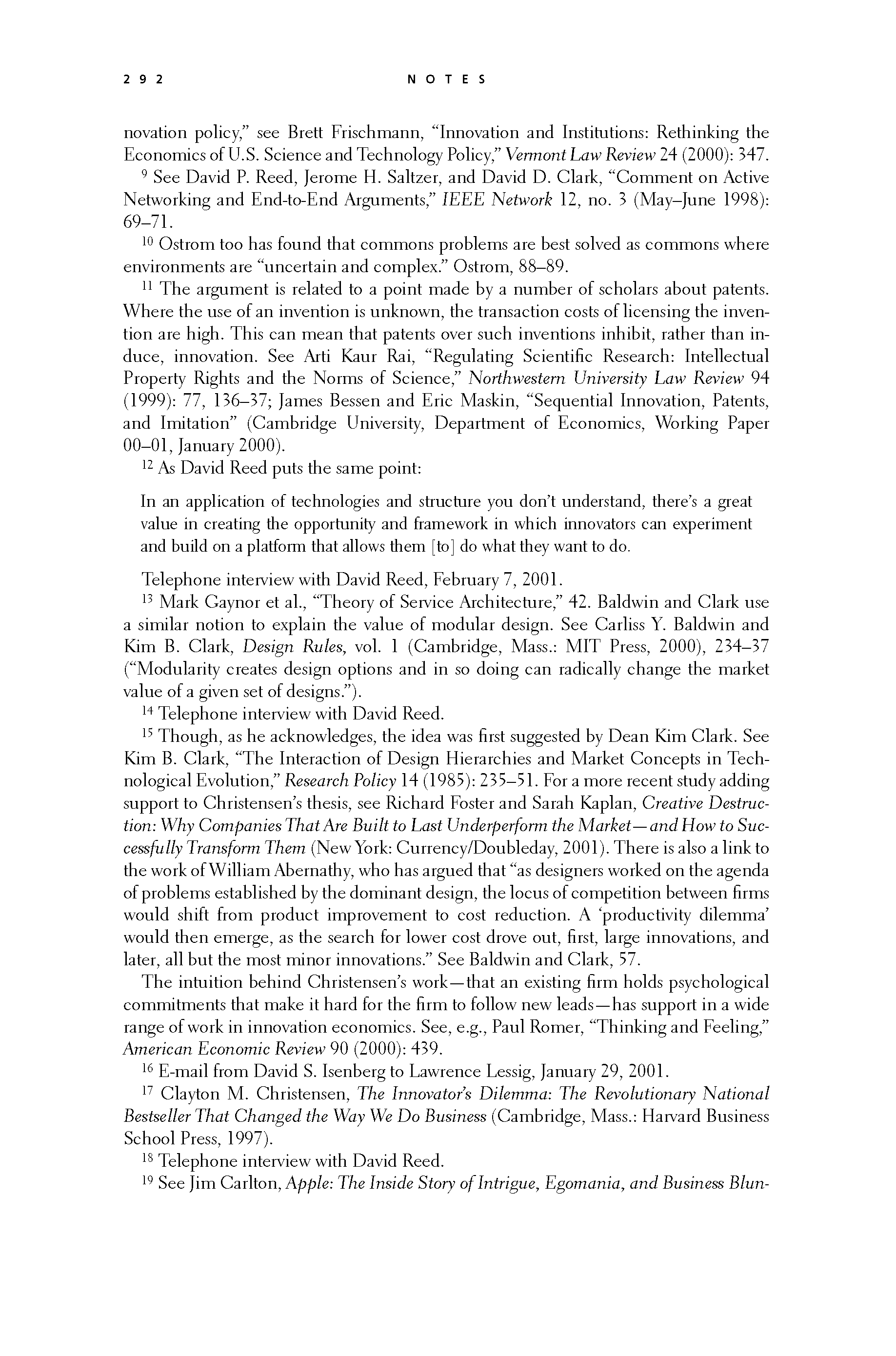 p291 _
-chap- _
toc-1 _
p292w _
toc-2 _
+chap+ _
p293
p291 _
-chap- _
toc-1 _
p292w _
toc-2 _
+chap+ _
p293
novation policy," see Brett Frischmann, "Innovation and Institutions: Rethinking the
Economics of U.S. Science and Technology Policy," _Vermont_Law_Review_ 24 (2000): 347.
[6-9] See David P. Reed, Jerome H. Saltzer, and David D. Clark, "Comment on Active
Networking and End-to-End Arguments," _IEEE_Network_ 12, no. 3 (May-June 1998):
69-71.
[6-10] Ostrom too has found that commons problems are best solved as commons where
environments are "uncertain and complex." Ostrom, 88-89.
[6-11] The argument is related to a point made by a number of scholars about patents.
Where the use of an invention is unknown, the transaction costs of licensing the inven-
tion are high. This can mean that patents over such inventions inhibit, rather than in-
duce, innovation. See Arti Kaur Rai, "Regulating Scientific Research: Intellectual
Property Rights and the Norms of Science," _Northwestern_University_Law_Review_ 94
(1999): 77, 136-137; James Bessen and Eric Maskin, "Sequential Innovation, Patents,
and Imitation" (Cambridge University, Department of Economics, Working Paper
00-01, January 2000).
[6-12] As David Reed puts the same point:
In an application of technologies and structure you don't understand, there's a great
value in creating the opportunity and framework in which innovators can experiment
and build on a platform that allows them [to] do what they want to do.
Telephone interview with David Reed, February 7, 2001.
[6-13] Mark Gaynor et al., "Theory of Service Architecture," 42. Baldwin and Clark use
a similar notion to explain the value of modular design. See Carliss Y. Baldwin and
Kim B. Clark, _Design_Rules,_ vol. 1 (Cambridge, Mass.: MIT Press, 2000), 234-237
("Modularity creates design options and in so doing can radically change the market
value of a given set of designs.").
[6-14] Telephone interview with David Reed.
[6-15] Though, as he acknowledges, the idea was first suggested by Dean Kim Clark. See
Kim B. Clark, "The Interaction of Design Hierarchies and Market Concepts in Tech-
nological Evolution," _Research_Policy_ 14 (1985): 235-251. For a more recent study adding
support to Christensen's thesis, see Richard Foster and Sarah Kaplan, _Creative_Destruc-_
_tion:_Why_Companies_That_Are_Built_to_Last_Underperform_the_Market_--_and_How_to_Suc-_
_cessfully_Transform_Them_ (New York: Currency/Doubleday, 2001). There is also a link to
the work of William Abernathy, who has argued that "as designers worked on the agenda
of problems established by the dominant design, the locus of competition between firms
would shift from product improvement to cost reduction. A 'productivity dilemma'
would then emerge, as the search for lower cost drove out, first, large innovations, and
later, all but the most minor innovations." See Baldwin and Clark, 57.
The intuition behind Christensen's work -- that an existing firm holds psychological
commitments that make it hard for the firm to follow new leads -- has support in a wide
range of work in innovation economics. See, e.g., Paul Romer, "Thinking and Feeling,"
_American_Economic_Review_ 90 (2000): 439.
[6-16] E-mail from David S. Isenberg to Lawrence Lessig, January 29, 2001.
[6-17] Clayton M. Christensen, _The_Innovator's_Dilemma:_The_Revolutionary_National_
_Bestseller_That_Changed_the_Way_We_Do_Business_ (Cambridge, Mass.: Harvard Business
School Press, 1997).
[6-18] Telephone interview with David Reed.
[6-19] See Jim Carlton, _Apple:_The_Inside_Story_of_Intrigue,_Egomania,_and_Business_Blun-_
[[292]]
p291 _
-chap- _
toc-1 _
p292w _
toc-2 _
+chap+ _
p293